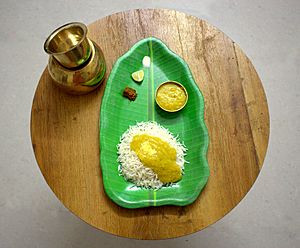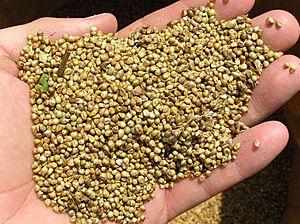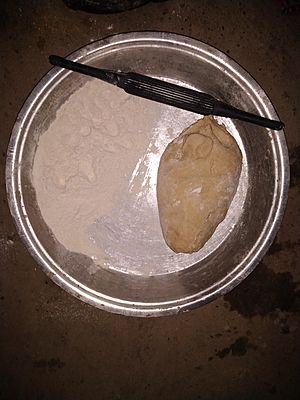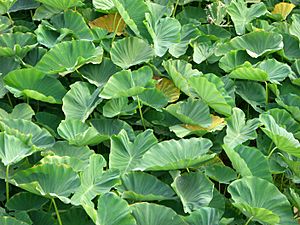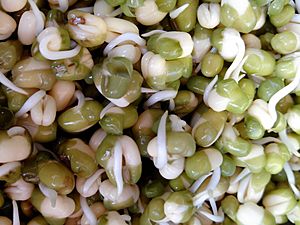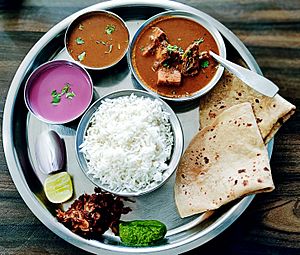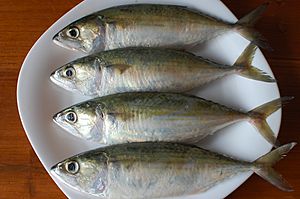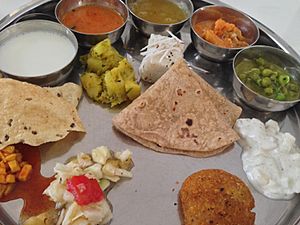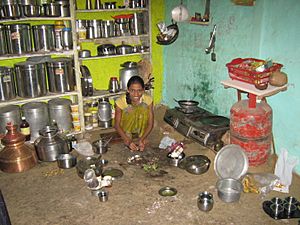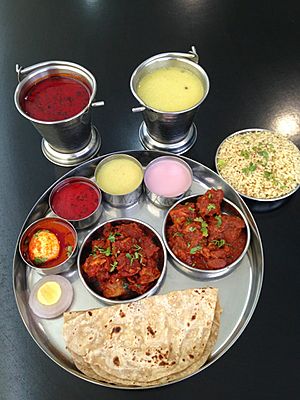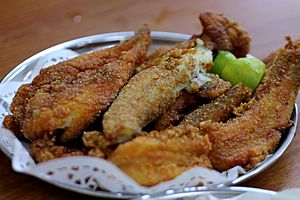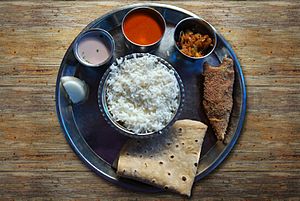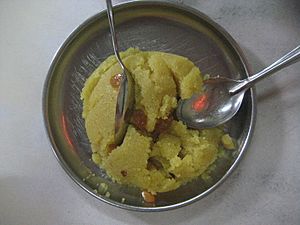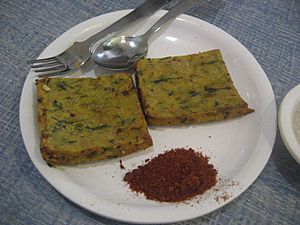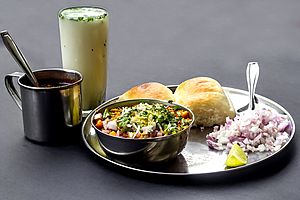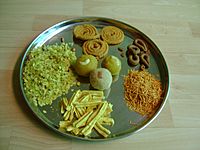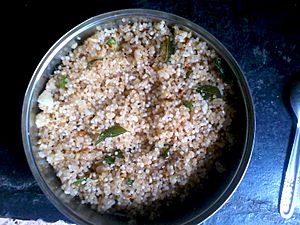Maharashtrian cuisine facts for kids
Maharashtrian (or Marathi) cuisine is the traditional food of the Marathi people from the Indian state of Maharashtra. It has its own special flavors, but it also shares many things with other Indian foods. People in Maharashtra have always thought of their food as simple and healthy.
Maharashtrian dishes can be mild or spicy. The main foods eaten are wheat, rice, jowar (a type of millet), bajri (another millet), vegetables, lentils, and fruit. You'll often find peanuts and cashews served with vegetables. In the past, meat was not eaten very often, mostly due to cost and culture.
In big cities like Mumbai, people also enjoy foods from other parts of India and the world. For example, South Indian dishes like idli and dosa are popular. You'll also find Chinese and Western foods like pizza in homes and restaurants.
Some unique Maharashtrian dishes include ukdiche modak, aluchi patal bhaji, Kande pohe, and Thalipeeth.
What's on the Plate: Everyday Meals
Maharashtra is a big state with different regions and types of food available. This means Marathi people from different areas have many kinds of dishes. Even within families, recipes can be unique because everyone uses their own mix of spices. Most Maharashtrians eat meat, fish, and eggs. However, the main diet for many people is mostly lacto-vegetarian (they eat dairy but no meat or eggs). Some groups, like the Brahmins, only eat vegetarian food.
In the central part of Maharashtra (the Deccan Plateau), the main meal usually includes bhakri (a flatbread), spiced cooked vegetables, dal (lentil soup), and rice. But people in North Maharashtra and cities prefer roti or chapati, which are flatbreads made from wheat.
Along the coast in the Konkan region, rice is the main food. Fresh coconut and coconut milk are used in many dishes there. In South Konkan, near Malvan, a special type of food called Malvani cuisine developed. It mostly includes non-vegetarian dishes. Kombdi vade (chicken with fried bread) and fish dishes are very popular.
In the Vidarbha region, people use less fresh coconut. Instead, they use dry coconut and peanuts in spicy dishes like savjis, and in mutton and chicken curries.
Maharashtrian vegetarian dishes use five main types of ingredients: grains, beans, vegetables, dairy, and spices.
Grains: The Main Course

The main dishes in Maharashtrian cooking are made with different kinds of flatbreads and rice. Flatbreads can be made from wheat, like the triangle-shaped ghadichi poli or the round chapati, which is common in cities. Bhakri is a flatbread made without yeast, using grains like ragi (finger millet), bajra, or jwari. Bhakri is eaten daily in rural areas.
Millet Power!
Traditionally, the main grains in the dry Deccan Plateau were millets like jwari and bajri. These crops grow well in dry areas. In the coastal Konkan region, ragi (finger millet) is used for bhakri. In the past, poor people in villages often ate simple meals of bajra bhakri with just a raw onion, a dry chutney, or a dish made from gram flour called jhunka. Today, jhunka with bhakri is a popular street food in Maharashtra.
Wheat: From Chapatis to Sweets
As more people moved to cities in Maharashtra, wheat became more popular. Wheat is used to make chapatis, ghadichi poli, deep-fried puri, or thick paratha. Wheat is also used in many stuffed flatbreads like Puran poli (with a sweet lentil filling), Gul poli (with sesame and jaggery), and Satorya (with sugar and dried milk).
Wheat flatbreads can also be stuffed with vegetables like peas, potatoes, and gram dal. Mande was an old, popular bread. Like rice, flatbreads are eaten with vegetables or dairy dishes.
Rice: A Coastal Favorite
Rice is the main food in the rural coastal Konkan region, but it's also popular in all cities. Local types of rice, like the fragrant ambemohar, are well-liked in Western Maharashtra. Most of the time, rice is boiled and served with other dishes. A popular dish is varan bhaat, where steamed rice is mixed with plain dal (made from pigeon peas), lemon juice, salt, and ghee (clarified butter). Khichdi is a popular rice dish made with rice, mung dal, and spices. For special events, a dish called masalebhat (rice with spices and vegetables) is common.
Dairy Delights
Milk is a very important food. Both cow milk and water buffalo milk are popular. Milk is mostly for drinking, adding to tea or coffee, or making homemade dahi (yogurt). Traditionally, yogurt is made fresh every day using a little bit of yesterday's yogurt to start the new batch. Dahi is used in many salads (koshimbir), to make Kadhi (a yogurt-based curry), or to make buttermilk (Taak). Buttermilk is also used in a drink called mattha by mixing it with spices. Milk is also needed to make butter and Ghee (clarified butter).
Fresh Vegetables

Until recently, canned or frozen food was not common in India. So, the vegetables used in meals depended on what was fresh and in season. In Maharashtra, spring (March–May) is the season for cabbages, onions, potatoes, okra, guar, tondali, shevgyachya shenga, dudhi, and padwal. During the Monsoon (June–September), green leafy vegetables like aloo (Marathi: आळू) or gourds like karle, dodka, and eggplant are available. Chili peppers, carrots, tomatoes, cauliflower, French beans, and peas are found in the cooler months (October–February).
Roasted young corn cobs of Sorghum (Jwari) are a popular snack during winter picnics.
Vegetables are usually made into bhaajis (Indian stews). Some bhaajis use one vegetable, while others mix several. Bhaajis can be "dry" (like a stir fry) or "wet" (like a curry). For example, fenugreek leaves can be cooked with mung dal or potatoes for a dry bhaaji. Or they can be mixed with besan (chickpea flour) and buttermilk to make a curry. Bhaajis often use goda masala, which is a blend of onion, garlic, ginger, red chili powder, green chilies, turmeric, and mustard seeds. Some families avoid onions and garlic during certain religious times.
Leafy vegetables like fenugreek, amaranth, beetroot, radish, dill, colocasia, spinach, ambadi, sorrel (Chuka), chakwat, safflower (Kardai), and tandulja are either stir-fried (pale bhaaji) or made into a soup (patal bhaaji) with buttermilk and gram flour.
Many vegetables are used in salads called koshimbirs or raita. Most of these have dahi (yogurt) as a main ingredient. Popular Koshimbirs include those with radish, cucumber, and tomato-onion. Some raita need the vegetable to be boiled or roasted first, like eggplant. Popular raita include those made with carrots, eggplant, pumpkin, dudhi, and beetroot.
Beans and Lentils
Besides green vegetables, different kinds of beans and lentils are also popular. Split beans are called dal and are made into amti (a thin lentil soup) or added to vegetables like dudhi. Dal can also be cooked with rice to make khichadi. Whole beans are cooked as they are, or more often, soaked in water until they sprout. Curries made from sprouted beans are called usal and are a great source of protein. Popular beans in Maharashtrian cooking include peas, chickpeas, mung, matki, urid, kidney bean, black-eyed peas, kulith, and toor (also called pigeon peas). Toor and chickpeas are very common. The urid bean is used to make a popular type of papadum.
Oils and Fats
Peanut oil and sunflower oil are the most common cooking oils. Cottonseed oil is also used. Ghee (clarified butter) is often used for its special flavor. It's served with Puran poli, Varan bhaat, chapati, and many other dishes. Fresh homemade butter is usually eaten with bhakri.
Spices and Herbs
Maharashtrian food can be mild or very spicy, depending on the region and family. Common spices include asafoetida, turmeric, mustard seeds, coriander, cumin, dried bay leaves, and chili powder. Spices used for the black kala masala blend include cinnamon, cloves, black pepper, cardamom, and nutmeg. Other popular spice blends are goda masala and Kolhapuri masala. Herbs like curry leaves and coriander leaves are used for flavor or to decorate dishes. Many curry recipes use garlic, onion, ginger, and green chili pepper. To make food taste sour, people use yogurt, tomatoes, tamarind paste, lemon, amsul skin, or unripe mangoes.
Meat and Poultry
Chicken and goat meat are the most popular meats in Maharashtrian cooking. Eggs are also popular and come from chickens. Some Maharashtrians also eat beef and pork, but these are not part of the traditional Maharashtrian cuisine.
Seafood Sensations
Seafood is a main food for many communities along the Konkan coast and is popular in other parts of the state too. Most recipes use marine fish, prawns, and crab. The special Malvani cuisine is mostly known for its seafood dishes. Popular fish include Bombay duck, pomfret, bangda, Rawas, and surmai (kingfish). Seafood dishes are prepared in different ways: curried, pan-fried, or steamed in banana leaves.
Other Important Ingredients
Other ingredients include seeds like flax, karale (Niger seed), coconut, peanuts, almonds, and cashew nuts. Peanut powder and whole nuts are used in many dishes, including chutney, koshimbir, and bhaaji. More expensive nuts like almonds and cashews are mainly used for sweet dishes. Flax and karale seeds are used to make dry chutneys. Traditionally, jaggery (a type of unrefined sugar from sugarcane) was used for sweetness, but now refined cane sugar is more common. Fruits like mango are used in many ways, including pickles, jams, drinks, and sweets. Bananas and jackfruit are also used in various dishes.
Typical Menus
In cities, meals usually have wheat flatbreads (chapatis) and plain rice as the main foods. In traditional rural homes, people on the Deccan plains eat millet bhakri, and those on the coast eat rice.
Typical breakfast items include misal, pohe, upma, sheera, sabudana khichadi, and thalipeeth. Some families fry leftover rice from the night before with onions, turmeric, and mustard seeds for breakfast, making phodnicha bhat. Western breakfasts like cereals, sliced bread, and eggs, as well as South Indian items like idli and dosa, are also popular. Tea or coffee is served with breakfast.
City Lunch and Dinner
Vegetarian lunch and dinner plates in cities usually have:
- Wheat flatbread like round chapati or ghadichi poli (layered triangle chapati)
- Boiled rice
- Salad or koshimbir made with onions, tomatoes, or cucumber
- Papad or similar snacks like sandge and kurdaya
- Dry or fresh chutney, mango or lemon pickles
- Aamti or varan (lentil soup) made from toor dal or other lentils, or kadhi (yogurt curry). If usal (sprouted bean curry) is served, aamti might be skipped.
- Vegetables with gravy, depending on what's in season (like eggplant, okra, potatoes, or cauliflower)
- Dry leafy vegetables like spinach
- Usal made from sprouted or unsprouted whole beans
Besides bread, rice, and chutney, other items can be changed. Families who eat meat, fish, and poultry might have both vegetarian and non-vegetarian dishes, with rice and chapatis as the main staples. The vegetable or non-vegetable dishes are usually eaten with bread or mixed with rice.
Traditional dinner items are placed in a circle. Salt is at the 12 o'clock position. Pickles, koshimbir, and other small dishes are placed counter-clockwise from the salt. Vegetable dishes are placed clockwise: leafy greens curry, dry vegetables, sprouted bean curry (usal), and dal. Rice is always on the outside, not in the middle.
Village Lunch and Dinner
In the inland areas of Maharashtra like Desh, Khandesh, Marathwada, and Vidarbha, the traditional main food was bhakri with dal, vegetables, or often pithale (made from chickpea flour). Wheat chapatis are now replacing bhakri more and more.
In the Konkan coastal area, boiled rice and rice bhakri or nachni bhakri are the main foods, served with a mix of vegetable and non-vegetable dishes.
Cooking Methods and Tools
Cooking on an open stove is the most common method. The traditional three-stone chulha (a type of stove) has mostly been replaced by kerosene or gas stoves. A stove can be used for many cooking methods:
- Phodani: This is a cooking method where spices like mustard seeds, cumin seeds, and turmeric, and sometimes ginger and garlic, are quickly fried in oil or ghee. This brings out their flavors. Other ingredients like vegetables or meat are then added. Phodani can be the first step in making a bhaaji or curry. It can also be the last step, used as a garnish.
- Simmering: Most curries and bhaajis are simmered (cooked slowly in liquid) until the meat or vegetables are tender.
- Deep frying: This is used for making fritters like onion bhaji or sweet fried dumplings (karanji).
- Pan frying: This uses very little oil, just enough to coat the pan. It's used for cooking delicate foods like fish.
- Tawa: This is a round metal pan used on an open stove to make flatbreads like ghadichi poli, chapatis, or bhakris.
- Steaming: This method is mainly used for special dishes like ukadiche modak or aluchya wadya.
- Roasting: Vangyache bharit involves roasting eggplant over an open fire before mashing it and adding other ingredients.
- Pressure cooking: This method is widely used to cook lentils, meat, and rice much faster.
Other ways of preparing food include:
- Baking: Baking is rarely done at home. The bread buns or pav used in popular street foods like vadapav are baked by professional bakers.
- Sun drying: Papad, a popular snack, and similar products called papdya and kurdaya, are dried in the sun after being rolled out. These dried products can be stored for many months.
- Fermentation: This is mainly used for making dahi (yogurt) or homemade butter from cream.
Special Dishes
Many dishes are made for religious events, parties, or as restaurant items and street food.
Vegetarian Delights
Some vegetarian dishes include:
- Puran Poli: A sweet flatbread eaten with Saar (a thin soup), Bhaat (rice), Kuradai-papad, and bhaji.
Meat and Poultry Dishes
Meat dishes are prepared in many ways:
- Taambda rassa: A hot, spicy curry with red gravy from Kolhapur.
- Pandhara rassa: Also a goat curry from Kolhapur, but with a white gravy made from coconut milk.
- Popati (पोपटी): A chicken dish with eggs and val papdi from the Raigad district in the coastal region.
- Malvani chicken
- Kombdi vade: A dish from the Konkan region. It's deep-fried flatbreads made from spicy rice and urid flour, served with chicken curry, especially Malvani chicken curry.
Seafood Sensations
Seafood is a main food for many communities from the Konkan region. Popular dishes include:
- Prawn pullao rice
- Stuffed crabs
- Crab masala
- Malvani fish curries
- Kolambi masala
- Stuffed pomfret
- Bombay duck fry
- Prawns fry
- Bangada curry
- Dry Rawas (Rawasche sukhe)
- Fried surmai
- Fish koliwada
Curries and Gravies with Rice
Various vegetable curries or gravies are eaten with rice, usually for both lunch and dinner. Popular dishes include:
- Amti: Lentil or bean curry, mostly made from toor dal or other lentils like mung beans or chickpeas. Sometimes, vegetables are added to amti. A popular amti recipe includes drumsticks.
- Kadhi: This "curry" is made from a mix of buttermilk, yogurt, and chickpea flour (besan). Some recipes add fried balls made from besan.
- Solkadhi: This cold soup is made from coconut milk, garlic, cilantro, and kokam. It's a special dish from the coastal region.
- Saar: Thin, broth-like soups made from different dals or vegetables.
- Amsulache saar: Made with kokam.
Pickles and Condiments
- Chutney and preserves: Popular chutneys include those made from raw mango, mint, tamarind, cilantro, panchamrit, garlic, and mirachicha thecha. Dry chutneys are made from oil seeds like flax seed, peanut, sesame, coconut, and karale. Chutney made from the skin of roasted vegetables like bottle gourd is also popular. Most chutneys include green or red chili pepper for spice. Garlic can also be added.
- Metkut: A dry mix of roasted beans and spices.
- Lon'che (pickle): Maharashtrian pickles are made with salt, oil, and spices. Common vegetables and fruits used for pickling include unripe mango, lemons, Aonla, green chilies, and Bhokar.
- Muramba: Made with unripe mangoes, spices, and sugar.
Refreshing Beverages
In Maharashtra, guests were traditionally offered water and jaggery (Gulpani). Now, tea or coffee are more common. These drinks are served with milk and sugar. Sometimes, tea includes spices, fresh ginger, cardamom, or lemon grass. Coffee is served with milk or ground nutmeg. Other drinks include:
- Kairi cha panha: A cold drink made from raw mango and jaggery, popular in early summer.
- Piyush: A sweet drink made from shrikhand and buttermilk.
- Kokum sarbat: A cold drink made from kokum and sugar.
- Solkadhi: Made with kokum and coconut milk.
- Mattha: Spicy buttermilk, served cold.
- Sugar cane juice: Freshly squeezed from sugarcane. Many juice centers in Maharashtra serve this.
- Banana Shikran: Eaten with chapatis or puri as part of a meal.
- Masala doodh: Sweet and spicy milk.
Sweet Treats and Desserts

Desserts are an important part of festivals and special occasions. Typical desserts include:
- Puran poli: A flatbread stuffed with a sweet lentil and jaggery mix.
- Shrikhand: A sweet dish made from strained yogurt, sugar, and spices.
- Basundi: A sweet milk dish made from thickened milk.
- Kheer: A sweet pudding made from semolina and sugar.
- Modak: Steamed dumplings stuffed with coconut and jaggery. Sometimes, modak is deep-fried instead of steamed. Traditionally, these desserts are linked to specific festivals. For example, modak is made during the Ganpati Festival.
- Puran Poli is one of the most popular sweets. It's a buttery flatbread filled with jaggery, yellow gram (chana) dal, plain flour, cardamom powder, and ghee. It's eaten at almost all festivals. Puran Poli is usually served with milk or a sweet-and-sour dal called katachi amti. In villages, it was served with a thin hot sugar syrup called gulawani.
- Modak: A sweet dumpling that is steamed (ukdiche modak) or fried. Modak is made during the Ganesh Festival (around August). It's often offered to Lord Ganesha, as it's said to be his favorite sweet. The sweet filling is made from fresh grated coconut and jaggery. The soft outer shell is made from rice flour or wheat flour. The steamed version, ukdiche modak, is eaten hot with ghee.
- Chirote: A sweet made from semolina and plain flour.
- Anarsa: Made from soaked powdered rice with jaggery or sugar. Making the traditional anarsa batter takes three days.
- Basundi: A sweetened, thick milk dessert.
- Aamras: A thick pulp or juice made from mangoes, with added sugar and milk.
- Shrikhand: Strained yogurt flavored with sugar, saffron, cardamom, and charoli nuts. Shrikhand is served with puri on special days like Gudhipadwa (Marathi new year).
- Amrakhand: Shrikhand flavored with mango, saffron, cardamom, and charoli nuts.
- Ladu: Popular snacks traditionally made for Diwali. Ladus can be made from semolina, gram flour, or bundi.
- Pedha: Round balls made from a mix of khoa (dried milk), sugar, and saffron.
- Amba barfi: Made from mango pulp.
- Gul Poli: A stuffed wheat flatbread with gul (jaggery) paste.
- Amba poli (or mango poli): This is not a flatbread, but more like a pancake. It's made in summer by sun-drying thin layers of cooked mango pulp (sometimes with sugar) on flat plates. It can be stored for several months.
- Phanas poli (Jackfruit poli): Similar to Amba poli but made with jackfruit pulp.
- Ambavadi
- Chikki: A sweet made from sugar and peanuts or other nuts.
- Narali paak: A sugar and coconut cake.
- Dudhi halwa: A traditional dessert made with dudhi (bottle gourd) and milk.
Other sweets popular in Maharashtra and India include: Kheer, kaju katli, gulab jamun, jalebi, various kinds of barfi, and rasmalai.
Street Food and Snacks

In many big cities like Mumbai and Pune, fast food is very popular. The most common types are bhaji (fritters), vada pav, misalpav, and pav bhaji. More traditional snacks include sabudana khichadi, pohe, upma, sheera, and panipuri. Most Marathi fast food and snacks are vegetarian.
Some dishes like sev bhaji, misal pav, and patodi are regional specialties within Maharashtra.
- Chivda: Spiced flattened rice. It's also known as "Bombay mix" in the UK.
- Pohe: A snack made from pounded rice. It's usually served with tea and is often offered to guests. Kanda pohe (pohe with onion) is so common that sometimes arranged marriages are jokingly called kanda pohay. Other types include batata pohe (with diced potatoes) and dadpe pohe (raw pohe mixed with coconut, chilies, ginger, and lemon juice).
- Upma, sanja, or upeeth: Similar to South Indian upma. It's a thick porridge made from semolina with green chilies, onions, and other spices.
- Vada pav: A fast food dish with a fried mashed potato dumpling (vada) served in a wheat bread bun (pav). It's like the Indian version of a burger and is almost always served with a red garlic chutney and fried chilies. Vada pav is rarely made completely at home because home baking is not common.
- Pav bhaji: A fast food dish with a vegetable curry (Marathi: bhaji) served with a soft bread roll (pav).
- Misal Pav: A dish made from curried sprouted lentils, topped with batata bhaji, pohay, chivda, farsaan, raw chopped onions, and tomato. It's sometimes eaten with yogurt and usually served with a wheat-bread bun.
- Thalipeeth: A type of flatbread. It's usually spicy and eaten with yogurt. It's a popular traditional breakfast made using bhajani, a mix of roasted lentils.
- Sabudana Khichadi: Sautéed sabudana (pearls of sago palm), a dish often eaten on religious fasting days.
- Khichdi: Made of rice and dal with mustard seeds and onions for flavor.
- Varanfal: A traditional Maharashtrian dish made of dough pieces cooked in a Toor dal curry. Dal dhokli is a similar dish popular in Gujarat and Rajasthan.
- Chana daliche dheerde: A savory crepe made with chana dal.
Like most Indian cuisines, Maharashtrian food has many fried savory snacks, including:
- Aluchi vadi: Made from colocasia leaves rolled in chickpea flour, steamed, and then pan-fried.
- Kothimbirichi vadi: Made with cilantro leaves.
- Suralichi vadi: A savory snack made from gram flour and yogurt. It's yellowish, tightly rolled pieces, garnished with coconut, coriander leaves, and mustard.
- Bhelpuri: A savory snack and a type of chaat. It's made of puffed rice, chopped vegetables like tomatoes and onions, and a tangy tamarind sauce. Bhelpuri is often linked to Mumbai beaches. It's thought to have started in Mumbai's cafes and street-food stalls.
- Sevpuri: A type of chaat from Mumbai. It's strongly linked to street food but also served in nicer places. Supermarkets sell ready-to-eat packets of sev puri and similar snacks.
- Ragda pattice: A popular Mumbai fast food. It has two parts: ragda (a spicy stew made from dry peas) and fried potato patties.
- Dahipuri: A type of chaat from Mumbai. It's served with small puri shells, similar to those in pani puri. Dahi puri and pani puri chaats are often sold by the same vendors.
- Sabudana vada: A deep-fried snack made from sabudana. It's often served with spicy green chutney and hot chai (tea) and is best eaten fresh.
Festivals and Special Days
Makar Sankrant
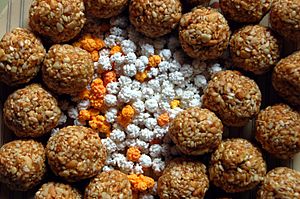
Makar Sankranti is usually on January 14. Maharashtrians exchange tilgul (sweets made of jaggery and sesame seeds) and say, tilgul ghya aani god bola (Marathi: तीळगुळ घ्या आणि गोड गोड बोला), which means "Accept the tilgul and be friendly." Tilgul Poli or gulpoli are the main sweet dishes. It's a wheat flatbread filled with sesame seeds and jaggery.
Mahashivratri
Marathi Hindu people fast on this day. Fasting food includes chutney made from the pulp of the kavath fruit (Wood apple). Some communities use the pulp of Bael fruit.
Holi
For Holi, a festival celebrated on the full moon evening in March or April, a bonfire is lit. This symbolizes the end of winter. People make puran poli as an offering to the holy fire. The day after the bonfire is called Dhulivandan. Marathi people celebrate with colors on Rangpanchami, the fifth day after the bonfire.
Gudi Padwa
On Gudi Padwa, most people make Puran poli, a sweet bread stuffed with chana dal (Puran). They eat it with Saar, bhat, Kuradai-papad, bhaji, and more. Some people make Puri with potato (batatyachi bhaaji) and bhaji. Shrikhand is also eaten on this day.
Ganesh Chaturthi
Modak is said to be Lord Ganesha's favorite food. Twenty-one pieces of this sweet are offered on Ganesh Chaturthi and other Ganesh-related events. Different Maharashtrian communities prepare special dishes for Gauri poojan.
Diwali
Diwali is one of the most popular Hindu festivals. In Maharashtrian tradition, family members take a special bath before dawn. Then, they have a breakfast of fried sweets and savory snacks called Diwali Faral. These snacks are offered to visitors and exchanged with neighbors. Typical sweet preparations include ladu, anarse, shankarpali, and karanjya. Popular savory treats include chakli, Shev, and chiwda. These snacks can be stored for many weeks because they are high in fat and low in moisture.
Champa Sashthi
Many Maharashtrian communities celebrate the Khandoba Festival or Champa Shashthi in December. Families set up a special altar for Khandoba during this festival. The sixth day is called Champa Sashthi. For many, the Chaturmas period (a four-month religious period) ends on Champa Shashthi. It's common for many families not to eat onions, garlic, and eggplant during Chaturmas. After the festival, they start eating these foods again with a special preparation of vangyache bharit (baingan bharta) with rodga.
Traditional Wedding Menu
The traditional wedding menu for Maharashtrian Hindu communities used to be vegetarian. It had many courses of rice dishes with different vegetables and dals. Some menus also included puris. In some communities, the first course was plain rice, and the second was dal with spiced rice. The main meal usually ended with plain rice and mattha (spiced buttermilk). Some popular curries for weddings and other festivals were those made from taro (Marathi: अलउ) leaves. Popular sweets for weddings were shreekhand, boondi ladu, and jalebi.
Hindu Fasting Cuisine
Marathi Hindu people fast on certain days, like Ekadashi (for Lord Vishnu), Chaturthi (for Lord Ganesha), Mondays (for Shiva), or Saturdays (for Maruti or Saturn). Only certain foods are allowed. These include milk and other dairy products (like dahi), fruit, and items like sago, potatoes, purple-red sweet potatoes, amaranth seeds, nuts, and varyache tandul (shama millet). Popular fasting dishes include Sabudana Khichadi or danyachi amti (peanut soup).
Christmas
The East Indian Catholic Community in North Konkan also has special recipes for Christmas. Like in Goa, these include pork vindaloo and sorpotel. A popular sweet for Christmas is Fogeas, made from flour, coconut milk, sugar, and cottage cheese. These sweets are offered to visitors and exchanged with neighbors and friends.



